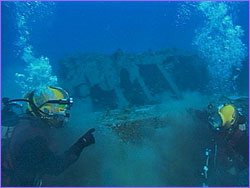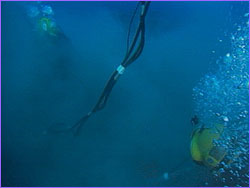
|

|
Back to Behind the Scenes On the expedition to film the USS Monitor, we used a custom-blended mixture of breathing gas called Trimix. We breathed this instead of air because at the Monitor's depth (234 feet), the pressure is such that breathing regular air would create a narcotic effect similar to drinking too much alcohol. This can be very dangerous, especially if you run into an emergency situation and need some good motor skills to get yourself out of trouble. Many divers have lost their lives diving deep on air and becoming lost, disoriented, or entangled inside wreckage. Diving on mixed gas costs a lot more than diving on air, but when weighed against your life, it doesn't seem so expensive. The bottom mix The gas mix we breathed on the bottom is called Trimix 18/50. It consisted of 18% oxygen, 50% helium, and the balance nitrogen. This mixture cuts down on the amount of excess nitrogen that is absorbed into your body during the dive and therefore lowers the narcotic effect (also known as nitrogen narcosis). There is one side effect of breathing mixed gas: When you speak, you sound a lot like Donald Duck. Fortunately, this is only a temporary problem.
At 234 feet, you are breathing air under pressure, so it takes a lot more air to fill your lungs on each breath (eight times as much to be exact). As such, we carried over 240 cubic feet of breathing gas on our backs in a set of double cylinders. In addition, we attached two 80-cubic-foot cylinders to a harness on our chests. One was a travel mix for breathing to and from the bottom and during decompression; the other was 100% oxygen for use during the shallowest portions of our decompression. Breathing 100% oxygen helps to dramatically reduce the amount of time it takes for the dissolved nitrogen in our blood to come out of our bodies. Decompression Because of the depth and length of our dives, we had to decompress on the way up after we shot on the bottom. This consisted of a series of stops starting at 110 feet and then slowly working our way up to the surface in 10-foot increments for a prescribed period of time. The shallower we got, the longer the stop lasted. We ended up spending most of our decompression at 20 and 10 feet. The average decompression from a typical 30-minute dive was around two hours. I actually enjoy decompression on an expedition like that one; it's a chance to relax a bit. You just have to be careful not to fall asleep! Dive gear double 120-cubic-foot tanks 2 single 80-cubic-foot tanks 4 regulators 3 pressure gauges mask and fins dry suit two digital depth gauges with built-in bottom timers slate dive tables with emergency decompression tables safety reel lift bag and divers sausage (inflatable balloon for signaling position) emergency canister with marine radio and EPERB (emergency radio beacon) This may seem like a lot of gear and although it is more than what would normally be carried on a typical dive, when configured properly it can be fairly streamlined and not as cumbersome as it sounds. —D.J. Roller Tour the Monitor | Behind the Scenes Eyewitness to the Battle | Steam Machine | Resources Transcript | Site Map | Lincoln's Secret Weapon Home Editor's Picks | Previous Sites | Join Us/E-mail | TV/Web Schedule | About NOVA Watch NOVAs online | Teachers | Site Map | Shop | Search | To Print PBS Online | NOVA Online | WGBH © | Updated May 2003 |

